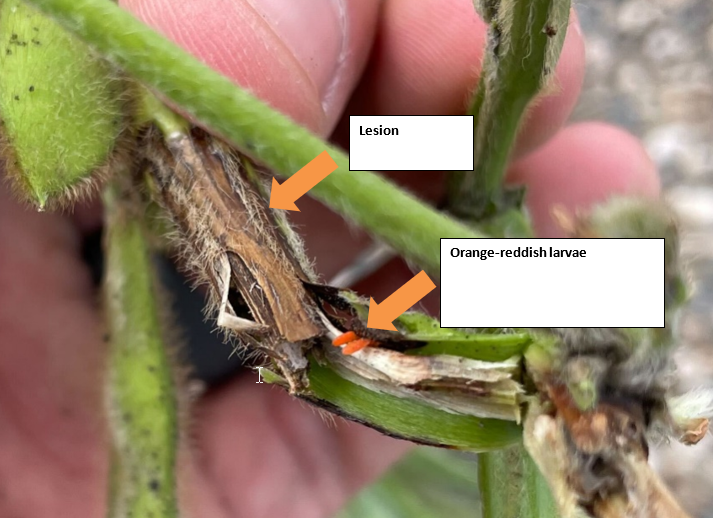Soybean Gall Midge – ‘Tentatively’ Confirmed in ND
This page was adapted from the article, "Soybean Gall Midge – ‘Tentatively’ Confirmed in ND ," which appeared in Crop & Pest Report on September 22, 2022
Two gall midge flies are associated with soybeans: the soybean gall midge, Resseliella maxima Gagné, and the white-mold gall midge, Karshomyia caulicola (Coquillett). The soybean gall midge is a new economic insect pest of soybeans, which first was reported causing yield losses in Nebraska, Iowa, and South Dakota soybean fields in 2018. This pest also was detected in Minnesota in 2018 and Missouri in 2019. The known distribution of soybean gall midge continues to expand in the five infested states, and infestations in South Dakota and Minnesota border southeastern North Dakota.
We recently were alerted to a possible soybean gall midge in a soybean field near Gwinner, Sargent County, by Brandon Schulzetenberg, Centrol Crop Consulting. After looking at the pictures of ‘larvae in the stem lesion’ (Figure 1) and the lack of white mold infection in the field, we quickly visited the field. After 8 hours of scouting, we finally found one stem with a lesion on the field edge that had about 10 tiny white to orange-reddish larvae. The infestation was obviously very low due to the difficulties in finding one midge-infested stem. The lesion was located mid-plant, which suggests that this was the second generation of soybean gall midge.

Larvae were collected and carefully placed in a 95% alcohol vial, and then sent to Dr. Justin McMechan’s laboratory at the University of Nebraska for DNA testing on whether it is a positive match for soybean gall midge or white-mold gall midge. DNA results are pending for soybean gall midge. However, the DNA results for the white-mold gall midge were negative.
NDSU Extension Entomology has been proactive in surveying for soybean gall midge since 2019. A total of 78 fields in 11 counties in 2019; 605 fields in 47 counties in 2020 and 588 fields in 48 counties in 2021 were surveyed. All fields were found negative in 2019, 2020 and 2021. In 2022, we surveyed 435 soybean fields in 45 counties for soybean gall midge that were negative pending the ‘tentative’ confirmation for the one field in Sargent County.
What to Do if You Find Suspect Soybean Gall Midge in North Dakota - If you happen to find white or orange larvae in the stems of soybeans, you need to confirm whether it is the soybean gall midge or white-mold gall midge. Collect more than 10 larvae and place them in alcohol vials, or collect two to three plants with larvae and place them in a plastic bag. Notify and send collected samples to the Extension agent in your county or to NDSU Extension Entomology for further identification. For more information, see the NDSU Extension publication on Soybean Gall Midge and White-mold Gall Midge in Soybean E2006.
Integrated Pest Management (IPM) of Soybean Gall Midge - Because the soybean gall midge is a newly discovered insect pest, entomologists have been studying different integrated pest management strategies in the infested states. Studies on planting dates, host plant resistance, crop rotation, tillage and insecticide control for this pest are being conducted in states with economic populations. For more information, see the websites on soybean gall midge that summarizes the IPM research:
- Soybean Gall Midge, Soybean Research and Information Network
- Midwest Soybean Gall Midge Discussion Series, University of Minnesota Extension
- Soybean Gall Midge Alert Network, University of Nebraska Extension
